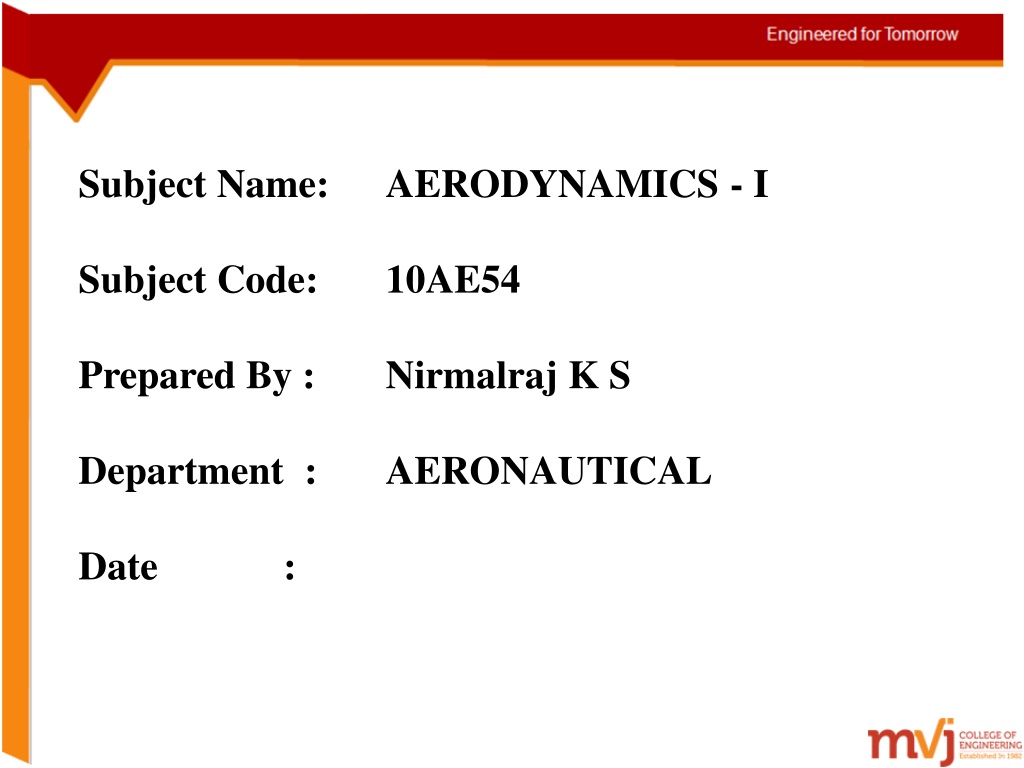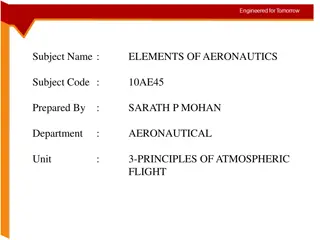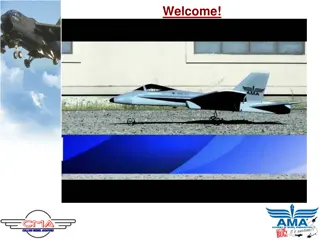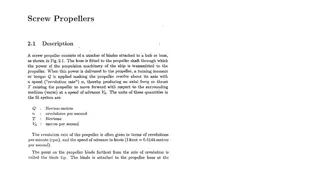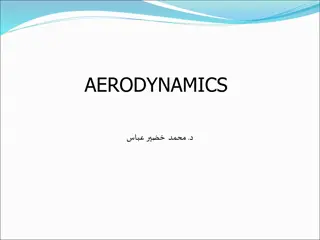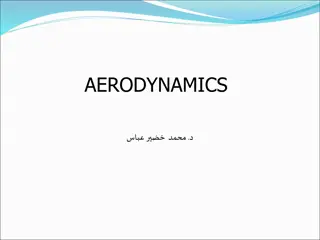Fundamentals of Aerodynamics in Aeronautics
This content delves into key topics of aerodynamics including the Navier-Stokes equation, boundary layer concepts, drag force, lift force, viscous flow, and effects of viscosity on boundary layers. It discusses drag prediction methods, boundary layer thickness, and the impact of viscosity on fluid dynamics. The role of pressure forces, shear forces, and boundary layer separation in aerodynamics is explored, providing a comprehensive understanding of airflow behavior around objects in the field of aeronautics.
Download Presentation

Please find below an Image/Link to download the presentation.
The content on the website is provided AS IS for your information and personal use only. It may not be sold, licensed, or shared on other websites without obtaining consent from the author.If you encounter any issues during the download, it is possible that the publisher has removed the file from their server.
You are allowed to download the files provided on this website for personal or commercial use, subject to the condition that they are used lawfully. All files are the property of their respective owners.
The content on the website is provided AS IS for your information and personal use only. It may not be sold, licensed, or shared on other websites without obtaining consent from the author.
E N D
Presentation Transcript
Subject Name: AERODYNAMICS - I Subject Code: 10AE54 Prepared By : Nirmalraj K S Department : AERONAUTICAL Date :
CONTENTS Navier-stokes equation Boundary layer concept Displacement, momentum & energy thickness Shear stress, Skin friction coefficient & drag force Viscous flow over 2-D streamlined body & bluff bodies Aspects of boundary layer separation airfoil stall
The drag force The surrounding fluid exerts pressure forces and viscous forces on an object. p < 0 U w U p > 0 The components of the resultant force acting on the object immersed in the fluid are the drag force and the lift force. The drag force acts in the direction of the motion of the fluid relative to the object. The lift force acts normal to the flow direction. Both are influenced by the size and shape of the object and the Reynolds number of the flow. 3
Drag prediction The drag force is due to the pressure and shear forces acting on the surface of the object. The tangential shear stresses acting on the object produce friction drag (or viscous drag). Friction drag is dominant in flow past a flat plate and is given by the surface shear stress times the area: Pressure or form drag results from variations in the the normal pressure around the object: In order to predict the drag on an object correctly, we need to correctly predict the pressure field and the surface shear stress. This, in turn, requires correct treatment and prediction of boundary layers and flow separation. We will discuss both in this lecture. A F . , = = A F, p da d pressure n d viscous w 4
Viscous boundary layer An originally laminar flow is affected by the presence of the walls. Flow over flat plate is visualized by introducing bubbles that follow the local fluid velocity. Most of the flow is unaffected by the presence of the plate. However, in the region closest to the wall, the velocity decreases to zero. The flow away from the walls can be treated as inviscid, and can sometimes be approximated as potential flow. The region near the wall where the viscous forces are of the same order as the inertial forces is termed the boundary layer. The distance over which the viscous forces have an effect is termed the boundary layer thickness. The thickness is a function of the ratio between the inertial forces and the viscous forces, i.e. the Reynolds number. As Re increases, the thickness decreases. 5
Effect of viscosity The layers closer to the wall start moving right away due to the no-slip boundary condition. The layers farther away from the wall start moving later. The distance from the wall that is affected by the motion is also called the viscous diffusion length. This distance increases as time goes on. The experiment shown on the left is performed with a higher viscosity fluid (100 mPa.s). On the right, a lower viscosity fluid (10 mPa.s) is shown. 6
Moving plate boundary layer An impulsively started plate in a stagnant fluid. When the wall in contact with the still fluid suddenly starts to move, the layers of fluid close to the wall are dragged along while the layers farther away from the wall move with a lower velocity. The viscous layer develops as a result of the no-slip boundary condition at the wall. 7
Viscous boundary layer thickness Exact equations for the velocity profile in the viscous boundary layer were derived by Stokes in 1881. Start with the Navier-Stokes equation: 2 u u t y = 2 Derive exact solution for the velocity profile: y t z = 2 01 U U erf 2 = t ( ) erf z e dt 2 0 erf is the error function: The boundary layer thickness can be approximated by: 2 0 2 t y t U U u u = 0 2 t 8
Flow separation Flow separation occurs when: the velocity at the wall is zero or negative and an inflection point exists in the velocity profile, and a positive or adverse pressure gradient occurs in the direction of flow. 9
Separation at sharp corners Corners, sharp turns and high angles of attack all represent sharply decelerating flow situations where the loss in energy in the boundary layer ends up leading to separation. Here we see how the boundary layer flow is unable to follow the turn in the sharp corner (which would require a very rapid acceleration), causing separation at the edge and recirculation in the aft region of the backward facing step. 10
Flow around a truck Flow over non-streamlined bodies such as trucks leads to considerable drag due to recirculation and separation zones. A recirculation zone is clear on the back of the cab, and another one around the edge of the trailer box. The addition of air shields to the cab roof ahead of the trailer helps organize the flow around the trailer and minimize losses, reducing drag by up to 10-15%. 11
Flow separation in a diffuser with a large angle 12
Inviscid flow around a cylinder The origins of the flow separation from a surface are associated with the pressure gradients impressed on the boundary layer by the external flow. The image shows the predictions of inviscid, irrotational flow around a cylinder, with the arrows representing velocity and the color map representing pressure. The flow decelerates and stagnates upstream of the cylinder (high pressure zone). It then accelerates to the top of the cylinder (lowest pressure). Next it must decelerate against a high pressure at the rear stagnation point. 13
Drag on a smooth circular cylinder = 1 2 F C v A drag D 2 The drag coefficient is defined as follows: no separation steady separation unsteady vortex shedding laminar BL wide turbulent wake turbulent BL narrow turbulent wake 14
Separation - adverse pressure gradients Separation of the boundary layers occurs whenever the flow tries to decelerate quickly, that is whenever the outer pressure gradient is negative, or the pressure gradient is positive, sometimes referred to as an adverse pressure gradient. In the case of the tennis ball, the flow initially decelerates on the upstream side of the ball, while the local pressure increases in accord with Bernoulli s equation. Near the top of the ball the local external pressure decreases and the flow should accelerate as the potential energy of the pressure field is converted to kinetic energy. However, because of viscous losses, not all kinetic energy is recovered and the flow reverses around the separation point. 18
Turbulent boundary layer Increased momentum transport due to turbulence from the free stream flow to the flow near the wall makes turbulent boundary layers more resistant to flow separation. The photographs depict the flow over a strongly curved surface, where there exists a strong adverse (positive) pressure gradient. The boundary layer has a high momentum deficit. In the case where the boundary layer is laminar, insufficient momentum exchange takes, the flow is unable to adjust to the increasing pressure and separates from the surface. In case where the flow is turbulent, the increased transport of momentum (due to the Reynolds stresses) from the free-stream to the wall increases the streamwise momentum in the boundary layer. This allows the flow to overcome the adverse pressure gradient. It eventually does separate nevertheless, but much further downstream. 19
Tripping the boundary layer Here we see how the addition of a trip wire to induce transition to turbulence changes the separation line further to the rear of the sphere, reducing the size of the wake and thus drastically diminishing overall drag. This well-known fact can be taken advantage of in a number of applications, such as dimples in golf balls and turbulence generation devices on airfoils. 20
Sports balls Many games involve balls designed to use drag reduction brought about by surface roughness. Many sports balls have some type of surface roughness, such as the seams on baseballs or cricket balls and the fuzz on tennis balls. It is the Reynolds number (not the speed, per se) that determines whether the boundary layer is laminar or turbulent. Thus, the larger the ball, the lower the speed at which a rough surface can be of help in reducing the drag. Typically sports ball games that use surface roughness to promote an early transition of the boundary layer from a laminar to a turbulent flow are played over a Reynolds number range that is near the trough of the Cd versus Re curve, where drag is lowest. 21
Flow in reference frame relative to the ball Note that we have been showing flow fields in the reference frame of the object, similar to the flow around the soccer ball shown here. 22
Flow in absolute reference frame However, one should keep in mind that the flow in the absolute reference frame may look quite different, as shown here. 23
Airfoil - effect of angle of attack The loss in pressure in the separated flow region behind solid bodies causes an imbalance between the upstream and downstream forces, contributing greatly to an increased net drag force. In the case of streamlined airfoils at low angle of attack, separation occurs only at the tip, with minimal losses. As the angle of attack increases, the separation point moves upstream, leading to increased drag. 24
Airfoil - effect of shape The pressure field is changed by changing the thickness of a streamlined body placed in the flow. The acceleration and deceleration caused by a finite body width creates favorable and unfavorable pressure gradients. When the body is thin, there are only weak pressure gradients and the flow remains attached. As the body is made thicker, the adverse pressure gradient resulting from the deceleration near the rear leads to flow separation, recirculation, and vortex shedding. Focusing in on the rear region of the flow, it is seen that as the body is again reduced in thickness, the separated region disappears as the strengths of the adverse pressure gradient is diminished. 25
Suction Just as flow separation can be understood in terms of the combined effects of viscosity and adverse pressure gradients, separated flows can be reattached by the application of a suitable modification to the boundary conditions. In this example, suction is applied to the leading edge of the airfoil at a sharp angle of attack, removing the early separation zone, and moving the separation point much farther downstream. 26
Blowing Separation in external flows, such as the flow past a sudden expansion can be controlled not only by suction but also by blowing. In this video, the region of separated flow is eliminated by the introduction of high momentum fluid at a point near the separation point. This acts to eliminate the adverse pressure gradient by accelerating the fluid close to the boundary, leading to re-attachment of the flow. 27
The turbulent boundary layer In turbulent flow, the boundary layer is defined as the thin region on the surface of a body in which viscous effects are important. The boundary layer allows the fluid to transition from the free stream velocity U to a velocity of zero at the wall. The velocity component normal to the surface is much smaller than the velocity parallel to the surface: v << u. The gradients of the flow across the layer are much greater than the gradients in the flow direction. The boundary layer thickness is defined as the distance away from the surface where the velocity reaches 99% of the free-stream velocity. u = = , . 0 99 y where U 28
